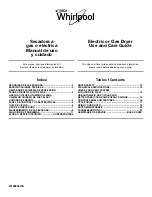
46
Using Your Dryer
Check the care labels inside the garments to determine whether the garment manufacturer
recommends tumble-drying.
Sorting
It is best that you sort your garments before placing them
into the dryer. Sort into loads of similar types, and loads that
take similar times to dry.
Heavier items (e.g. towels, t-shirts and flannel sheets) are
best dried separately from lightweight items (e.g. synthetics,
poly-cotton sheets and shirts). This prevents the possibility of
some items becoming over-dried whilst others are still damp.
It will also help to extend the life of your clothing and linen.
Drying your clothes as soon as the washer has finished will
decrease the chance of
wrinkles
and the chance of dye
transfer from colored items to white items.
We recommend that articles of clothing with screen-printing
are turned inside out to ensure the screen-printing does
not stick to the drum. Garments with hooks or zippers need
to be fastened and where possible turned inside out. Place
undergarments in a net bag to provide protection from other
items in the load.
Loading
Garments need to be loaded properly to reduce the
likelihood of them wrinkling and to ensure the load is dried
evenly. Make sure there is ample room for the garments to
tumble freely while drying. Load in terms of the space the
garments take up when dry, rather than when they are wet.
The general rule is one wash load = one dryer load.
Only load the dryer up to the top of the transparent
section of the lint bucket. Loading any higher may result in
uneven drying, tangling, wrinkling and the dryer becoming
overloaded.
It is a good idea to dry ‘permanent press’ type garments
together in a separate cycle with the
WRINKLE FREE
option turned on. This will help reduce wrinkles and the
need for ironing.
Load no higher
than here
Summary of Contents for AeroSmart DE27CW1
Page 111: ......
















































